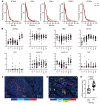STING agonist 8803 reprograms the immune microenvironment and increases survival in preclinical models of glioblastoma
- PMID: 38941297
- PMCID: PMC11178548
- DOI: 10.1172/JCI175033
STING agonist 8803 reprograms the immune microenvironment and increases survival in preclinical models of glioblastoma
Abstract
STING agonists can reprogram the tumor microenvironment to induce immunological clearance within the central nervous system. Using multiplexed sequential immunofluorescence (SeqIF) and the Ivy Glioblastoma Atlas, STING expression was found in myeloid populations and in the perivascular space. The STING agonist 8803 increased median survival in multiple preclinical models of glioblastoma, including QPP8, an immune checkpoint blockade-resistant model, where 100% of mice were cured. Ex vivo flow cytometry profiling during the therapeutic window demonstrated increases in myeloid tumor trafficking and activation, alongside enhancement of CD8+ T cell and NK effector responses. Treatment with 8803 reprogrammed microglia to express costimulatory CD80/CD86 and iNOS, while decreasing immunosuppressive CD206 and arginase. In humanized mice, where tumor cell STING is epigenetically silenced, 8803 therapeutic activity was maintained, further attesting to myeloid dependency and reprogramming. Although the combination with a STAT3 inhibitor did not further enhance STING agonist activity, the addition of anti-PD-1 antibodies to 8803 treatment enhanced survival in an immune checkpoint blockade-responsive glioma model. In summary, 8803 as a monotherapy demonstrates marked in vivo therapeutic activity, meriting consideration for clinical translation.
Keywords: Brain cancer; Cancer immunotherapy; Immunology; Oncology; Signal transduction.
Figures







References
MeSH terms
Substances
Grants and funding
LinkOut - more resources
Full Text Sources
Research Materials
Miscellaneous

